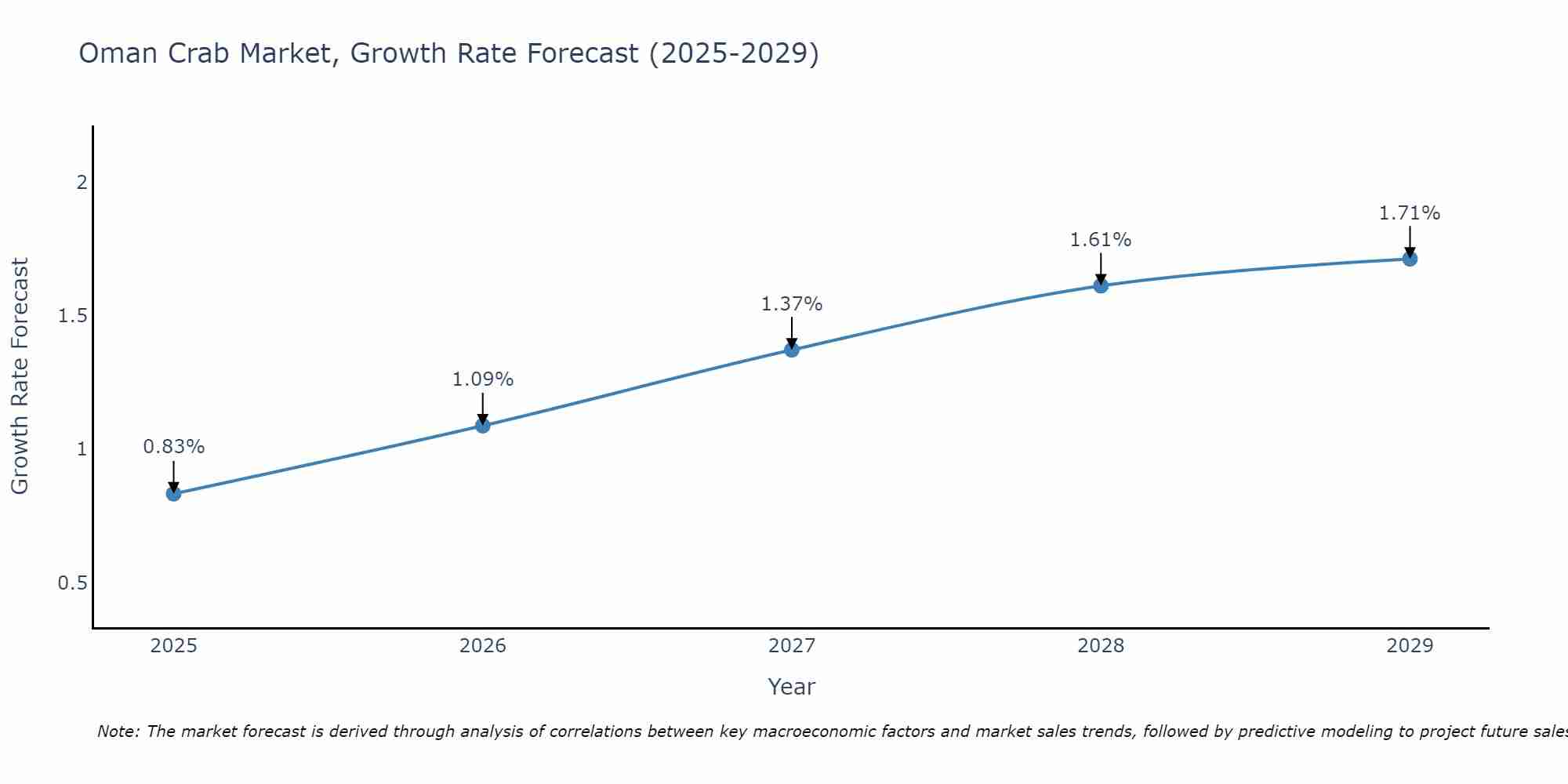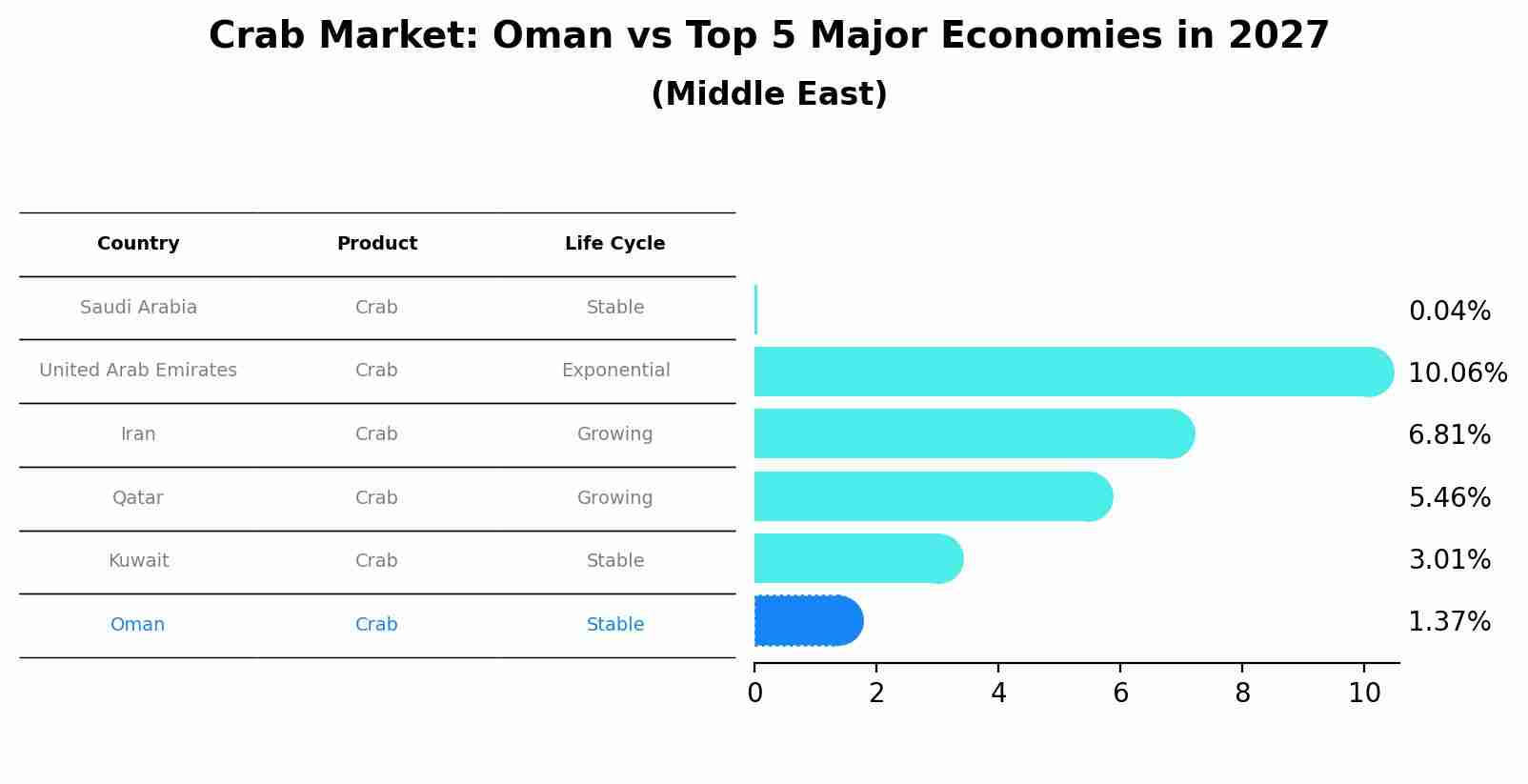Oman Crab Market Outlook | Forecast, Size, Analysis, COVID-19 IMPACT, Trends, Share, Companies, Value, Industry, Growth & Revenue
| Product Code: ETC088862 | Publication Date: Jun 2021 | Updated Date: Jun 2025 | Product Type: Report | |
| Publisher: 6Wresearch | Author: Shubham Deep | No. of Pages: 70 | No. of Figures: 35 | No. of Tables: 5 |
Oman Crab Market Size Growth Rate
The Oman Crab Market is likely to experience consistent growth rate gains over the period 2025 to 2029. The growth rate starts at 0.83% in 2025 and reaches 1.71% by 2029.

Crab Market: Oman vs Top 5 Major Economies in 2027 (Middle East)
By 2027, Oman's Crab market is forecasted to achieve a stable growth rate of 1.37%, with Saudi Arabia leading the Middle East region, followed by United Arab Emirates, Iran, Qatar and Kuwait.

Oman Crab Market Overview
The Oman crab market is characterized by a growing demand for high-quality crabs both domestically and internationally. Oman`s strategic location along the Arabian Sea provides abundant opportunities for crab fishing, with the country being known for its diverse range of crab species including blue crabs, brown crabs, and king crabs. The market is driven by a combination of factors such as increasing consumer awareness of the health benefits of crab consumption, rising popularity of seafood dishes, and a growing tourism sector that boosts demand for fresh seafood. Key players in the Oman crab market include local fishermen, seafood processing companies, and exporters who cater to both the local market and export markets in Asia, Europe, and the Middle East. Sustainable fishing practices and stringent quality control measures are increasingly important in maintaining the reputation of Oman`s crab exports in the global market.
Oman Crab Market Trends
The Oman Crab Market is experiencing growth driven by increasing consumer demand for seafood products. Key trends include a focus on sustainable fishing practices to preserve crab populations and meet eco-conscious consumer preferences. There is a growing interest in premium crab varieties, such as the Omani rock crab, known for its sweet and delicate flavor. The market is also seeing a rise in value-added crab products, including pre-cooked and ready-to-eat options to cater to convenience-seeking consumers. Additionally, technological advancements in processing and packaging are enhancing the quality and shelf life of crab products, expanding market reach both domestically and internationally. Overall, the Oman Crab Market is poised for continued expansion with a focus on sustainability, quality, and innovation driving growth.
Oman Crab Market Challenges
In the Oman Crab Market, some of the key challenges faced include fluctuating demand due to seasonal variations in crab availability, competition from imported crab products, and the impact of environmental factors on crab populations. The market also grapples with issues such as inconsistent quality standards, limited access to modern technology for processing and storage, and the need for sustainable fishing practices to ensure long-term viability. Additionally, logistical challenges in terms of transportation and distribution can hinder the market`s growth potential. Overall, addressing these challenges will require investment in infrastructure, technology, and market diversification strategies to enhance competitiveness and sustainability in the Oman Crab Market.
Oman Crab Market Investment Opportunities
The Oman Crab Market presents promising investment opportunities due to the increasing global demand for seafood, particularly premium products like Omani crabs known for their exquisite taste and quality. Investors can consider opportunities in crab farming and aquaculture, as well as processing and exporting operations to cater to international markets. With Oman`s strategic location and growing reputation as a seafood exporter, investments in modernizing infrastructure, technology, and sustainable practices within the crab industry can yield significant returns. Additionally, partnerships with local fishermen and businesses can provide access to a reliable supply chain and enhance market competitiveness. Overall, the Oman Crab Market offers a lucrative investment landscape for those looking to capitalize on the rising demand for high-quality seafood products.
Oman Crab Market Government Policy
The Oman Crab Market is regulated by the Ministry of Agriculture and Fisheries Wealth in Oman through various policies aimed at sustainable management and conservation of crab populations. These policies include licensing requirements for crab fishing, restrictions on fishing seasons and areas to prevent overexploitation, and minimum size limits to protect juvenile crabs. The government also periodically reviews and updates these policies in consultation with stakeholders to ensure the long-term viability of the crab industry and the marine ecosystem. Additionally, there are strict penalties for violations of these regulations to deter illegal fishing practices and protect the crab population for future generations. Overall, the government policies in Oman aim to balance the economic interests of the crab industry with environmental sustainability and conservation efforts.
Oman Crab Market Future Outlook
The Oman Crab Market is expected to experience steady growth in the coming years due to increasing demand for seafood products both domestically and internationally. Factors driving this growth include rising consumer awareness of the health benefits of crab meat, as well as the growing popularity of seafood cuisine in Oman. Additionally, advancements in fishing techniques and technologies are likely to enhance the efficiency of crab harvests, ensuring a stable supply for the market. However, challenges such as environmental concerns and sustainability issues may impact the market`s growth trajectory. Overall, the Oman Crab Market is poised for expansion, with opportunities for market players to capitalize on the rising demand for high-quality crab products both in Oman and in global markets.
Key Highlights of the Report:
- Oman Crab Market Outlook
- Market Size of Oman Crab Market, 2021
- Forecast of Oman Crab Market, 2027
- Historical Data and Forecast of Oman Crab Revenues & Volume for the Period 2018 - 2027
- Oman Crab Market Trend Evolution
- Oman Crab Market Drivers and Challenges
- Oman Crab Price Trends
- Oman Crab Porter's Five Forces
- Oman Crab Industry Life Cycle
- Historical Data and Forecast of Oman Crab Market Revenues & Volume By Type for the Period 2018 - 2027
- Historical Data and Forecast of Oman Crab Market Revenues & Volume By Blue Crab for the Period 2018 - 2027
- Historical Data and Forecast of Oman Crab Market Revenues & Volume By Chinese Mitten Crab for the Period 2018 - 2027
- Historical Data and Forecast of Oman Crab Market Revenues & Volume By Gazami Crab for the Period 2018 - 2027
- Historical Data and Forecast of Oman Crab Market Revenues & Volume By Others for the Period 2018 - 2027
- Historical Data and Forecast of Oman Crab Market Revenues & Volume By Form for the Period 2018 - 2027
- Historical Data and Forecast of Oman Crab Market Revenues & Volume By Frozen for the Period 2018 - 2027
- Historical Data and Forecast of Oman Crab Market Revenues & Volume By Canned for the Period 2018 - 2027
- Historical Data and Forecast of Oman Crab Market Revenues & Volume By Others for the Period 2018 - 2027
- Oman Crab Import Export Trade Statistics
- Market Opportunity Assessment By Type
- Market Opportunity Assessment By Form
- Oman Crab Top Companies Market Share
- Oman Crab Competitive Benchmarking By Technical and Operational Parameters
- Oman Crab Company Profiles
- Oman Crab Key Strategic Recommendations
Frequently Asked Questions About the Market Study (FAQs):
1 Executive Summary |
2 Introduction |
2.1 Key Highlights of the Report |
2.2 Report Description |
2.3 Market Scope & Segmentation |
2.4 Research Methodology |
2.5 Assumptions |
3 Oman Crab Market Overview |
3.1 Oman Country Macro Economic Indicators |
3.2 Oman Crab Market Revenues & Volume, 2021 & 2027F |
3.3 Oman Crab Market - Industry Life Cycle |
3.4 Oman Crab Market - Porter's Five Forces |
3.5 Oman Crab Market Revenues & Volume Share, By Type, 2021 & 2027F |
3.6 Oman Crab Market Revenues & Volume Share, By Form, 2021 & 2027F |
4 Oman Crab Market Dynamics |
4.1 Impact Analysis |
4.2 Market Drivers |
4.3 Market Restraints |
5 Oman Crab Market Trends |
6 Oman Crab Market, By Types |
6.1 Oman Crab Market, By Type |
6.1.1 Overview and Analysis |
6.1.2 Oman Crab Market Revenues & Volume, By Type, 2018 - 2027F |
6.1.3 Oman Crab Market Revenues & Volume, By Blue Crab, 2018 - 2027F |
6.1.4 Oman Crab Market Revenues & Volume, By Chinese Mitten Crab, 2018 - 2027F |
6.1.5 Oman Crab Market Revenues & Volume, By Gazami Crab, 2018 - 2027F |
6.1.6 Oman Crab Market Revenues & Volume, By Others, 2018 - 2027F |
6.2 Oman Crab Market, By Form |
6.2.1 Overview and Analysis |
6.2.2 Oman Crab Market Revenues & Volume, By Frozen, 2018 - 2027F |
6.2.3 Oman Crab Market Revenues & Volume, By Canned, 2018 - 2027F |
6.2.4 Oman Crab Market Revenues & Volume, By Others, 2018 - 2027F |
7 Oman Crab Market Import-Export Trade Statistics |
7.1 Oman Crab Market Export to Major Countries |
7.2 Oman Crab Market Imports from Major Countries |
8 Oman Crab Market Key Performance Indicators |
9 Oman Crab Market - Opportunity Assessment |
9.1 Oman Crab Market Opportunity Assessment, By Type, 2021 & 2027F |
9.2 Oman Crab Market Opportunity Assessment, By Form, 2021 & 2027F |
10 Oman Crab Market - Competitive Landscape |
10.1 Oman Crab Market Revenue Share, By Companies, 2021 |
10.2 Oman Crab Market Competitive Benchmarking, By Operating and Technical Parameters |
11 Company Profiles |
12 Recommendations |
13 Disclaimer |
- Single User License$ 1,995
- Department License$ 2,400
- Site License$ 3,120
- Global License$ 3,795
Search
Thought Leadership and Analyst Meet
Our Clients
Related Reports
- Afghanistan Apparel Market (2026-2032) | Growth, Outlook, Industry, Segmentation, Forecast, Size, Companies, Trends, Value, Share, Analysis & Revenue
- Canada Oil and Gas Market (2026-2032) | Share, Segmentation, Value, Industry, Trends, Forecast, Analysis, Size & Revenue, Growth, Competitive Landscape, Outlook, Companies
- Germany Breakfast Food Market (2026-2032) | Industry, Share, Growth, Size, Companies, Value, Analysis, Revenue, Trends, Forecast & Outlook
- Australia Briquette Market (2025-2031) | Growth, Size, Revenue, Forecast, Analysis, Trends, Value, Share, Industry & Companies
- Vietnam System Integrator Market (2025-2031) | Size, Companies, Analysis, Industry, Value, Forecast, Growth, Trends, Revenue & Share
- ASEAN and Thailand Brain Health Supplements Market (2025-2031) | Strategy, Consumer Insights, Analysis, Investment Trends, Opportunities, Growth, Size, Share, Industry, Revenue, Segments, Value, Segmentation, Supply, Forecast, Restraints, Outlook, Competition, Drivers, Trends, Demand, Pricing Analysis, Competitive, Strategic Insights, Companies, Challenges
- ASEAN Bearings Market (2025-2031) | Strategy, Consumer Insights, Analysis, Investment Trends, Opportunities, Growth, Size, Share, Industry, Revenue, Segments, Value, Segmentation, Supply, Forecast, Restraints, Outlook, Competition, Drivers, Trends, Demand, Pricing Analysis, Competitive, Strategic Insights, Companies, Challenges
- Europe Flooring Market (2025-2031) | Outlook, Share, Industry, Trends, Forecast, Companies, Revenue, Size, Analysis, Growth & Value
- Saudi Arabia Manlift Market (2025-2031) | Outlook, Size, Growth, Trends, Companies, Industry, Revenue, Value, Share, Forecast & Analysis
- Uganda Excavator, Crane, and Wheel Loaders Market (2025-2031) | Strategy, Consumer Insights, Analysis, Investment Trends, Opportunities, Growth, Size, Share, Industry, Revenue, Segments, Value, Segmentation, Supply, Forecast, Restraints, Outlook, Competition, Drivers, Trends, Demand, Pricing Analysis, Competitive, Strategic Insights, Companies, Challenges
Industry Events and Analyst Meet
Whitepaper
- Middle East & Africa Commercial Security Market Click here to view more.
- Middle East & Africa Fire Safety Systems & Equipment Market Click here to view more.
- GCC Drone Market Click here to view more.
- Middle East Lighting Fixture Market Click here to view more.
- GCC Physical & Perimeter Security Market Click here to view more.
6WResearch In News
- Doha a strategic location for EV manufacturing hub: IPA Qatar
- Demand for luxury TVs surging in the GCC, says Samsung
- Empowering Growth: The Thriving Journey of Bangladesh’s Cable Industry
- Demand for luxury TVs surging in the GCC, says Samsung
- Video call with a traditional healer? Once unthinkable, it’s now common in South Africa
- Intelligent Buildings To Smooth GCC’s Path To Net Zero


















